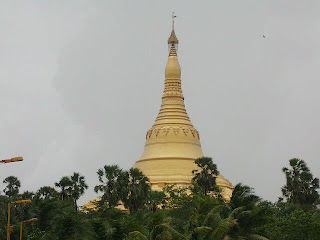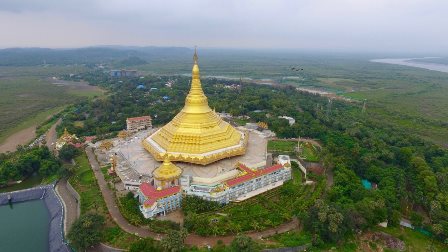All are most welcome to visit the Global Vipassana
Pagoda, to immensely benefit from practicing Vipassana - and experience the true work and purpose
of human life.
Vipassana is for all (*1).
Visiting the Global Pagoda is free of charge. No entry fee. No charges for the tour guide.
Timings: 9.00 am to 7.00 pm.
Open all days, including Sunday.
(Ferry Timings: Every 15 minutes from Gorai Jetty. Last ferry to Global Pagoda leaves at 5.25 pm)
* Drinking water, clean wash-room facilities available in the Global Pagoda premises.
* The Food Plaza serves quality vegetarian food at economical prices. Catering for large groups of visitors can be booked at 022-3374 7536.
* Non-commercial photography is permitted - with the understanding that there can be no copyright to any image of the Global Vipassana Pagoda. Visuals are to be made freely available to all for non-commercial use. (* For any clarification, please contact Global Vipassana Foundation, Mumbai, India, Telephone: 91 - 22 - 33747501; Email: pr@globalpagoda.org)
 |
| Global Vipassana Pagoda |
Reaching Global Vipassana Pagoda by Road from Mumbai City / Domestic Airport / International Airport / Railway Stations in Mumbai
Pre-paid taxi services are available at the Mumbai domestic
and international airports. Ask for "Global Vipassana Pagoda"
or "Essel World". The Global Pagoda is adjacent to Esselworld Park in
Gorai island.
From Bhayandar suburban railway station , Western Railway line (third station after Borivali, from Churchgate station), exit on the western (left) side of station, and take Mira-Bhayandar Muncipal Transport (MBMT) Bus No 4 to Global Vipassana Pagoda, Gorai.(This is considered the more convenient, economical option, as the bus goes right up to the main Myanmar Gate entrance to the Global Vipassana Pagoda.)
From Bhayandar suburban railway station , Western Railway line (third station after Borivali, from Churchgate station), exit on the western (left) side of station, and take Mira-Bhayandar Muncipal Transport (MBMT) Bus No 4 to Global Vipassana Pagoda, Gorai.(This is considered the more convenient, economical option, as the bus goes right up to the main Myanmar Gate entrance to the Global Vipassana Pagoda.)
From Borivali Railway station:
A major station in the Western Railway, Mumbai, Borivili is also well connected by Maharashtra State Transport Buses from Thane, Navi Mumbai & Mumbai cities. Please exit from the western side of the station (from Churchgate, the exit is on the left). You can walk to Chandavarkar Road (towards the pedestrian skywalk) which is perpendicular to the railway line on the North End of the station. Shared auto-rickshaws (tuk-tuks) are available., or please take BEST Bus no. 294 and 247 to Gorai Creek (Also known as Gorai ‘Khadi’ in local language). Shared auto rickshaw to Gorai Creek fare is approx Rs 10 (with three other passengers), and can be about three times that amount for single hire.
The Gorai jetty for the ferry to Global Pagoda is about five-ten minutes ride from Borivili station (3.8 kms).
Other Bus Numbers to Gorai: From Kurla railway station (West) - 309 L; From Mulund station (West) - 460 L;From Ghatkopar Bus Depot - 488 L (please re-confirm before boarding bus)
---
Vipassana students meditating inside the Global Pagoda dome
* Google Map Road directions to Global Vipassana Pagoda, from your location in Mumbai
Have a happy, most beneficial visit to the Global Pagoda - and a life filled with pure happiness.
Have a happy, most beneficial visit to the Global Pagoda - and a life filled with pure happiness.
For more details, assistance:
Global Vipassana PagodaTelephone: 91 22 33747501 (30 lines)
Email: pr@globalpagoda.org
Pagoda Address:
Global Vipassana Pagoda
Next to Esselworld, Gorai Village,
Borivali (West), Mumbai 400091
Postal address:
Head Office Global Vipassana Foundation
2nd Floor, Green House, Green Street, Fort
Mumbai – 400 023
Telephone: +91 22 22665926 / 22664039; Fax: +91 22 22664607
--
Dhamma Pattana Vipassana Centre
Inside Global Vipassana Pagoda Campus
Next to Esselworld, Gorai Village,
Borivali (West), Mumbai 400091
Tel: [91] (22) 3374 7519; Fax: [91] (22) 3374 7518
Email: info@pattana.dhamma.org
* Online application for 10-day Vipassana courses
* Dhamma reasons why no fees are charged for Vipassana courses - including for boarding and lodging
* Rare opportunities to earn and share merits participating in Global Vipassana Pagoda projects
*(1) Buddha: Super Scientist of Peace. Part-1 of Most Compassionate, Most Revered Sayagyi U Goenka's address to the United Nations, New York, 2002.
*(1) Buddha: Super Scientist of Peace. Part-1 of Most Compassionate, Most Revered Sayagyi U Goenka's address to the United Nations, New York, 2002.






